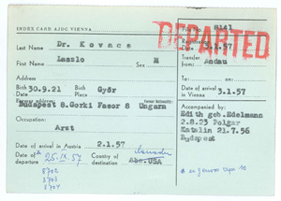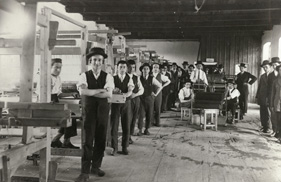 |
T A B L E O F C O N T E N T S
J U L Y / A U G U S T 2 0 1 5
Volume 21, Number 7/8
DOI: 10.1045/july2015-contents
ISSN: 1082-9873
E D I T O R I A L
Twenty Years and Counting
Editorial by Laurence Lannom, Corporation for National Research Initiatives
O P I N I O N
The DOI — Twenty Years On
Opinion by Mark Bide
Abstract: In a slightly unusual twist to our normal practice with opinion pieces we present, with permission, we present the transcript of a talk given by Mark Bide at a recently held IDF (International DOI Foundation) meeting. The IDF Registration Agencies such as CrossRef and DataCite gather twice a year to discuss ongoing efforts and to plan for the future. The summer meeting this year was celebrating the 20th anniversary of 'The Armati Report' that led fairly directly to the creation of the Digital Object Identifier (DOI). Mark, speaking in a personal capacity, takes a long view of the accomplishments of the last twenty years as well as the challenges that remain.
A R T I C L E S
Data Stewardship in the Earth Sciences
Article by Robert R. Downs, Columbia University, Ruth Duerr, University of Colorado at Boulder, Denise J. Hills, Geological Survey of Alabama and H. K. Ramapriyan, Science Systems and Applications, Inc. and NASA Goddard Space Flight Center
Abstract: Science data collection and documentation practices have changed radically over the last several hundred years, most importantly since the advent of the digital age. Data centers, as repositories for that science data, only had their genesis in the early twentieth century, yet have in excess of 50 years experience managing digital science data. In the Earth Sciences, for the past 15+ years, the Federation of Earth Science Information Partners (ESIP) has been working to make Earth science data more discoverable, accessible, and usable by more people. As a part of this effort, the ESIP Data Stewardship Committee has worked on a variety of recommendations, best practices, and guidelines that have significantly moved data stewardship in the Earth sciences forward, with impacts ranging from influencing how data management is done within government agencies and by other data stewards, to providing guidelines for citation of Earth science data used by publishers in the Earth sciences. Completed and ongoing activities of the committee are described. Interested readers are invited to join our community.
The Role of Libraries in Science 2.0: Focus on Economics
Article by Stephanie B. Linek, ZBW — Leibniz Information Centre for Economics, Germany and Josefine Bäßler, HAW — Hamburg University of Applied Sciences, Germany
Abstract: The presented empirical study explores the role of modern libraries in Science 2.0. The main focus lies on the researchers' needs for an optimised use of Web 2.0 for scientific work. The participants were economists of different academic levels. We used a multi-method approach. First, three focus group interviews were conducted gaining information about the use of Web 2.0. Second, three individual interviews investigated the behaviour of frequent Twitter users. Third, to receive quantitative data on the issue, an online survey was conducted. The findings revealed that researchers were in principle open to the new opportunities of Web 2.0. However, so far, the Web 2.0 services of libraries were often unknown. Besides others, there were two remarkable findings: there was a wish for privacy which is reflected in the discrete use of different social networks for private versus professional purposes. Additionally, researchers express the need for academic, reliable networks but often did not know about existing ones (e.g., ResearchGate, Academia). The findings suggest that researchers are often not aware of the possibilities of Web 2.0 for their scientific work. Libraries could close this gap and provide necessary information about appropriate Web 2.0 services.
Developing an Image-Based Classifier for Detecting Poetic Content in Historic Newspaper Collections
Article by Elizabeth Lorang, Leen-Kiat Soh, Maanas Varma Datla and Spencer Kulwicki, University of Nebraska—Lincoln
Abstract: The Image Analysis for Archival Discovery (Aida) project team is investigating the use of image analysis to identify poetic content in historic newspapers. The project seeks both to augment the study of literary history by drawing attention to the magnitude of poetry published in newspapers and by making the poetry more readily available for study, as well as to advance work on the use of digital images in facilitating discovery in digital libraries and other digitized collections. We have recently completed the process of training our classifier for identifying poetic content, and as we prepare to move to the deployment stage, we are making available our methods for classification and testing in order to promote further research and discussion. The precision and recall values achieved during the training (90.58%; 79.4%) and testing (74.92%; 61.84%) stages are encouraging. In addition to discussing why such an approach is needed and relevant and situating our project alongside related work, this paper analyzes preliminary results, which support the feasibility and viability of our approach to detecting poetic content in historic newspaper collections.
Evaluating the Impact of the FWF-E-Book-Library Collection in the OAPEN Library: An Analysis of the 2014 Download Data
Article by Ronald Snijder, OAPEN Foundation
Abstract: The FWF-E-Book-Library is the Open Access repository for all stand-alone publications funded by the Austrian Science Fund (FWF). This collection of e-books is also made available through the OAPEN Library. This paper analyses the usage of the FWF-E-book collection in the OAPEN Library during 2014, in order to measure scholarly impact and societal relevance in the humanities and social sciences. Every time a reader downloads a document, the Internet Protocol address of the provider—an organisation through which the reader accesses the web—is recorded. By combining the usage data and information about the provider, we can make an assumption about who is using a specific monograph. The influence of language is quite profound: books written in German are much more likely to be read within Germany, Austria or Switzerland, while books written in English have a far greater chance to be used all over the globe. Most of the usage is international; only 11% of the total downloads is national. The role of Germany and Switzerland is quite large, amounting to 42% of the total usage. The remaining 47% of the downloads originate from the rest of the world. The role of academic readers is relatively large, compared to governmental, business or non-profit usage. Yet, the biggest group of users have accessed the collection through an ISP. If the mean downloads per subject are analysed, we see large differences per subject: not all subjects enjoy the same amount of 'popularity'. It is clear that the collection has a wider reach than academics, and has been read not only in the German-speaking countries, but world-wide.
Semantic Enrichment: a Low-barrier Infrastructure and Proposal for Alignment
Article by Theo van Veen, Juliette Lonij and Hanna Koppelaar, Koninklijke Bibliotheek, National Library of the Netherlands
Abstract: Semantic enrichment provides new possibilities for discovery and presentation of our data. At the National Library of the Netherlands research department we have created a generic infrastructure for enriching objects from our collections with, for example, links to related information. This article summarizes the main ideas behind this infrastructure and presents its implementation, with particular reference to the enrichment process of extracting named entities from textual content and linking them to resource descriptions in the Linked Data cloud. Other content providers may take a similar approach when enriching their data. We argue that such initiatives will be more beneficial for our users when infrastructures are connected and accessible with the same APIs. Alignment of data formats and identifiers, moreover, can help connect our content to others' content, e.g. through the use of a single identifier for each relevant resource across collections and institutions.
"Bottled or Tap?" A Map for Integrating International Image Interoperability Framework (IIIF) into Shared Shelf and Artstor
Article by William Ying and James Shulman, Artstor
Abstract: Frustrated by the way in which media collections were growing up within individual collecting institutions that were in turn making individual technology decisions about data stores and presentation applications, a community of library technologists set out to design a set of protocols for calling, ordering, and using image files in standardized ways resulting in The International Image Interoperability Framework (IIIF). In this article, we map out how the non-profit organization Artstor (via its Shared Shelf asset management service and its Digital Library) are putting this emerging interoperability standard into practice.
N E W S & E V E N T S
In Brief: Short Items of Current Awareness
In the News: Recent Press Releases and Announcements
Clips & Pointers: Documents, Deadlines, Calls for Participation
Meetings, Conferences, Workshops: Calendar of Activities Associated with Digital Libraries Research and Technologies
|
 |
F E A T U R E D D I G I T A L
C O L L E C T I O N

American Jewish Joint Distribution Committee (JDC) Archives

AJDC Emigration Service index card for Laszlo Kovacs, who was among more than 11,000 Hungarian Jews who sought JDC assistance in Austria after fleeing Hungary as a result of the 1956 uprising. Kovacs later became a well-known Hollywood cinematographer. Vienna, 1957.
[Courtesy of American Jewish Joint Distribution Committee, Inc. Used with permission.]

A young refugee who fled Nazi-occupied France awaits his meal at a JDC-supported facility. Switzerland, 1943. [Courtesy of American Jewish Joint Distribution Committee, Inc. Used with permission.]

Yeshiva students in a vocational training program pose by their looms. Sighet, Romania, c.1920. Photograph by Stern. [Courtesy of American Jewish Joint Distribution Committee, Inc. Used with permission.]
The JDC Archives houses one of the most significant collections in the world for the study of modern Jewish history, reflecting activity in over 90 countries dating from 1914 to the present. Comprising the organizational records of JDC, the overseas rescue, relief, and rehabilitation arm of the American Jewish community, the archives includes documents, photographs, a research library, audio recordings including oral histories, and videos. Documents include eyewitness accounts, correspondence, reports, press releases, and lists of recipients of assistance.
In 2007, the JDC Archives initiated a digitization program to make its collections publicly accessible and searchable online. By the beginning of 2015, 2.4 million pages of documents and 63,000 photographs had been digitized. A Names Index with 500,000 entries is searchable via a separate API on the website; these names link to JDC documents that provide family history researchers with otherwise unavailable information about their ancestors, including names of relatives, towns of origin, and occupations. Database search features include fuzzy searching, useful for variant spellings of names, and the ability to search across collections (text, photos, names) using Quick Search, thereby connecting photos to related documents.
Finding aids are searchable online as are all text collections from JDC's New York office from its 1914 founding through 1974. Records of JDC offices and operations in Cyprus, Istanbul, and Stockholm are also available. Digitization of material from JDC's European headquarters in Geneva is well underway; to date, the period 1945-1954 has been completed.
In 2014, the Archives digitized the fugitive JDC Warsaw Office, 1945-1949 Collection, the originals of which are housed at the Jewish Historical Institute in Warsaw. Virtual reintegration of this historical collection with the archives' other digital material creates a richer story of JDC's activity in Europe immediately after the war than had previously been possible.
The JDC Archives is collaborating with other digital projects. These include Europeana, where JDC has shared its World War I-era collection; the European Holocaust Research Infrastructure (EHRI) portal, where it has posted finding aids for its Holocaust-era collections; and the Digital Library of the Caribbean, with which it will share its Dominican Republic Settlement Association (DORSA) collection.
D - L I B E D I T O R I A L S T A F F
Laurence Lannom, Editor-in-Chief
Allison Powell, Associate Editor
Catherine Rey, Managing Editor
Bonita Wilson, Contributing Editor
|